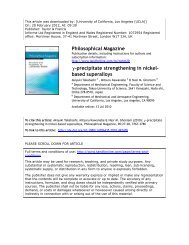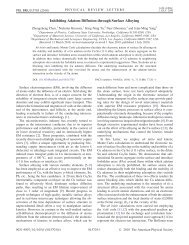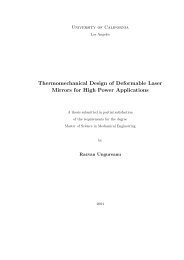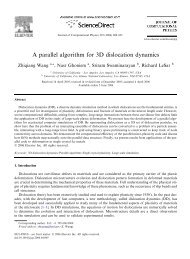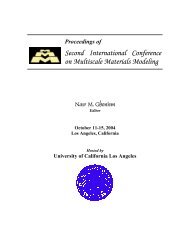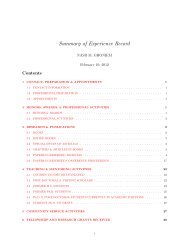FS&T Template - Nasr Ghoniem's Matrix Laboratory - UCLA
FS&T Template - Nasr Ghoniem's Matrix Laboratory - UCLA
FS&T Template - Nasr Ghoniem's Matrix Laboratory - UCLA
Create successful ePaper yourself
Turn your PDF publications into a flip-book with our unique Google optimized e-Paper software.
Sharafat et al.<br />
SiC-FOAM BASED FLOW CHANNEL INSERT FOR DCLL TBM<br />
of the FCI. They can take the form of either pressure<br />
equalization holes or slots. However, these features have<br />
not yet been designed and are currently not included in<br />
the analysis.<br />
the proposed SiC materials are produced by a CVD<br />
process. A potential advantage of using the combination<br />
of SiC-foam with CVD face sheets is that CVD SiC<br />
materials have been established to have good resistance to<br />
neutron irradiation damage. However, the radiation<br />
performance of SiC foam materials has yet to be<br />
validated.<br />
Figure 5 shows a micrograph of the proposed FCI<br />
structure, which consists of SiC foam between two CVD<br />
SiC face sheets. The parts with 12% SiC foam exhibited<br />
flexure strength of 50.3 ± 1.4 MPa, while the parts with<br />
22% SiC foam had a strength of 115.4 ± 7.4 MPa (Ref.<br />
11). The SiC foam is integrally attached (mechanically<br />
and chemically bonded) to the CVD SiC faceplate. For a<br />
100 pores per linear inch SiC-foam, there are 10,000<br />
support points per square inch for the SiC face sheet. The<br />
foam is integrally fused to the CVD-SiC face sheet,<br />
because of the nominally 1 to 2 pore depth penetration of<br />
the face sheet into the foam. The reticulated ligamental<br />
structure of SiC foams provides favorable thermomechanical<br />
properties, such as high thermal shock<br />
resistance and the ability to withstand steep temperature<br />
gradients, by reacting stress through small movements of<br />
individual ligaments. Fully dense SiC structures are not<br />
capable of reducing stress through this micro-distortion<br />
behavior, and can result in microcracks.<br />
Fig. 3: Schematic of the segmented FCI structure; also a<br />
cross sectional view of a single sector and a close-up view<br />
of the bracket are shown (dimensions are in mm).<br />
III.A. SiC Foam-based FCI Material<br />
SiC/SiC composites have been suggested as<br />
structural materials of FCIs. However, these advanced<br />
SiC/SiC composites have thermal and electrical<br />
conductivities, which are above the desired limits. Figure<br />
4 shows typical un-irradiated SiC/SiC composite<br />
materials properties. Depending on irradiation<br />
temperature, dose, and architecture, SiC/SiC can<br />
experience a wide range in thermal conductivity<br />
degradation of K irr /K o ratios between 0.1 and 0.6 between<br />
400 o C and 1000 o C (Ref. 10). An effort is currently<br />
underway to develop new SiC/SiC composites with 2-D<br />
fiber architecture to satisfy the key requirements of<br />
electrical- and thermal conductivity limits outlined earlier.<br />
Here we report on the use off-the-shelf CVD-based<br />
SiC materials for the FCI, consisting of open-cell SiC<br />
foam sandwiched between CVD SiC face sheets. SiCfoams<br />
are routinely manufactured at low cost compared<br />
with SiC/SiC composites, which fulfill FCI conductivity<br />
requirements. No significant R&D development,<br />
especially neutron irradiation data is necessary, as all of<br />
Fig. 4: Transverse thermal (top) and electrical (bottom)<br />
conductivities of un-irradiated SiC/SiC composites. 9<br />
Figure 6 shows the thermal and electrical<br />
conductivities of SiC foam as a function of temperature<br />
886 FUSION SCIENCE AND TECHNOLOGY VOL. 56 AUG. 2009



